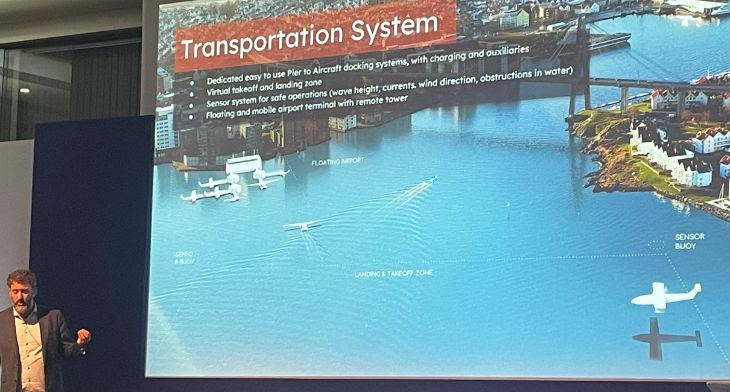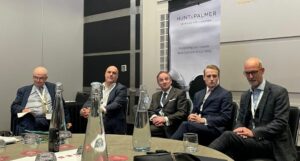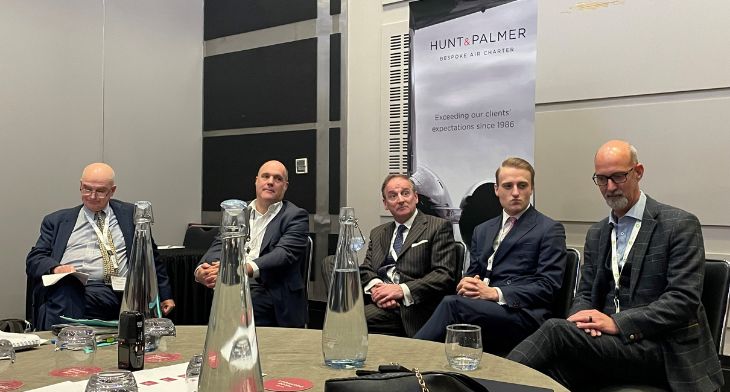


Amphibious aviation has a key role to play when it comes to the future of regional aviation, according to Eric Lithun, CEO and founder of Elfly, a pioneering company looking to usher in an era of sustainable short-haul travel with its all-electric seaplane, Noemi (an abbreviation of no emissions).
The resurgence of amphibious aviation
Speaking at this year’s British Business and General Aviation (BBGA) AGM, Lithun confirmed that Elfly is on track to fly its first test flight of the Noemi in 2026 before entering the market with commercial operations in 2030. While Noemi is designed to take-off and land on water it will also have the ability to land on airfields, giving it added versatility. “While current seaplane operations are based on conventional aircraft that have been modified with floats to enable them to land on water, Noemi, which will be built from composite materials and is inspired by boats with a hull, is designed to operate on water (fresh or saltwater) with twin electric engines powered by lithium batteries,” explained Lithun. “It offers an efficient and environmentally friendly air transport solution with low operational costs,” he continued.
Noemi will offer three cabin options. The “Ryanair configuration” as Lithun described it, will offer a 13-seat configuration and restricted capacity for luggage, while a six or nine seat layout will lend itself to VIP of business flights. A large door also means not only is the aircraft accessible for passengers in wheel chairs, but it can also be converted and used to carry freight.
The use cases for Noemi are multiple noted Lithun. From cargo operations to medical flights and VIP transfers to touristic flights as well as short-haul regional services, the amphibious aircraft could be used for a variety of services. But the obvious place to start is within existing seaplane markets, such as the Maldives, where the market for seaplanes is currently valued at around US$550 million per year.
In terms of the infrastructure required on the ground, or water, to accommodate these flights, Lithun said that Elfly is aiming to use standard charging technology that is currently being used by electric boats and cars. He also proposes using floating barges for aircraft docking and onboarding/ offloading passengers and baggage. “These could be moved around and relocated as and when needed depending on where the demand for flights is,” he said. There’s also additional opportunities to leverage revenue streams he said. “Depending on demand these floating landing structures could also house cafes and offer the charging infrastructure for other modes of transport including bikes, boats and cars.”
The big challenge with all-electric amphibious aviation currently is the lack of regulatory framework, which at the moment falls under the responsibility of the local authority. There needs to be more cohesion and guidance to facilitate safe, secure operations. But as Lithun concluded, “When it comes to social acceptance, amphibious aviation will be more widely accepted than eVOTL flights, because even in a city centre people are used to things happening on the water.”
On the subject of eVTOLS…


“We believe existing licensed, certified aerodromes are the place to start,” he said. “These will likely require minimum tweaks to get these vehicles airborne.”The consultation covers existing aerodromes and visual flight rules (VFR) operations only, not instrument flight rules (IFR) at the moment. The information we will get once we start flying these aircraft will form the basis for the regulations required for future flights and to develop bespoke vertiports, which will be established in city centres, in locations such as carpark rooftops and on rivers.”
He added that the CAA is hoping that by the end of 2024 regulations will be in place to allow for eVTOL operations.
London Oxford Airport’s James Dillon Godfray was sceptical. “We can’t see today how we could practically host conventional eVTOL type operations, so we remain agnostic in terms of the different operators and OEMs wanting to use our facility. But it will require significant sums of money to be pumped into the infrastructure to accommodate these services.”
SaxonAir CEO, Alex Durand, which operates out of Norwich Airport in East Anglia reiterated there is still a lot that needs to be proven before the investment in infrastructure can be made. “We operate the Velis Electro – the only certified electric aircraft currently and there are constant hurdles to operating a light aircraft in an existing facility. Scale that up and the challenges are enormous, especially when we’re talking about unproven, uncertified noise profiles and technology,” he said.
Another major challenge to eVTOL flights is the charging infrastructure that’s required, with Dillon Godfray asserting there is no commonality between the charging requirements and that has to change. “No airport will want to spend money installing a particular system that’s only applicable to one specific OEM,” he said. He also alluded to the potential two and a half year wait to plug in to the grid for access to the required megawatt or megawatts of energy required for fast charging capabilities.
Referencing the Helicopter Association International’s recent rebranding to Vertical Aviation International (VAI), Tim Fauchon described the wave of expansion being ushered in by new aircraft and technology as “the way ahead.” Echoing Dillon-Godfray he added: “We are totally agnostic and fully supportive of eVTOL development. But, for our members it’s about understanding the business case. They’re invested and many have signed agreements but the money hasn’t been laid out yet. The infrastructure needs to be there and they need to see how this will make money… But at the moment there’s no guarantee that if you take off from one location say in London that you’ll be able to land at your destination. Even if these flights are ready to go the infrastructure simply isn’t there yet. However, we have to start somewhere and the CAA are working hard to address these concerns and carry out the relevant risk assessments.”
Dillon-Godfray agreed: “We can forget any kind of commercial services in the near future. We simply don’t have the capacity to have these vehicles hanging around on the ground for charging. At the moment it’s about testing out this technology.” Describing 2026 as an unrealistic timeline for eVTOL operations, he did however conclude “maybe in a decade’s time we’ll see these flights actually in service.”






